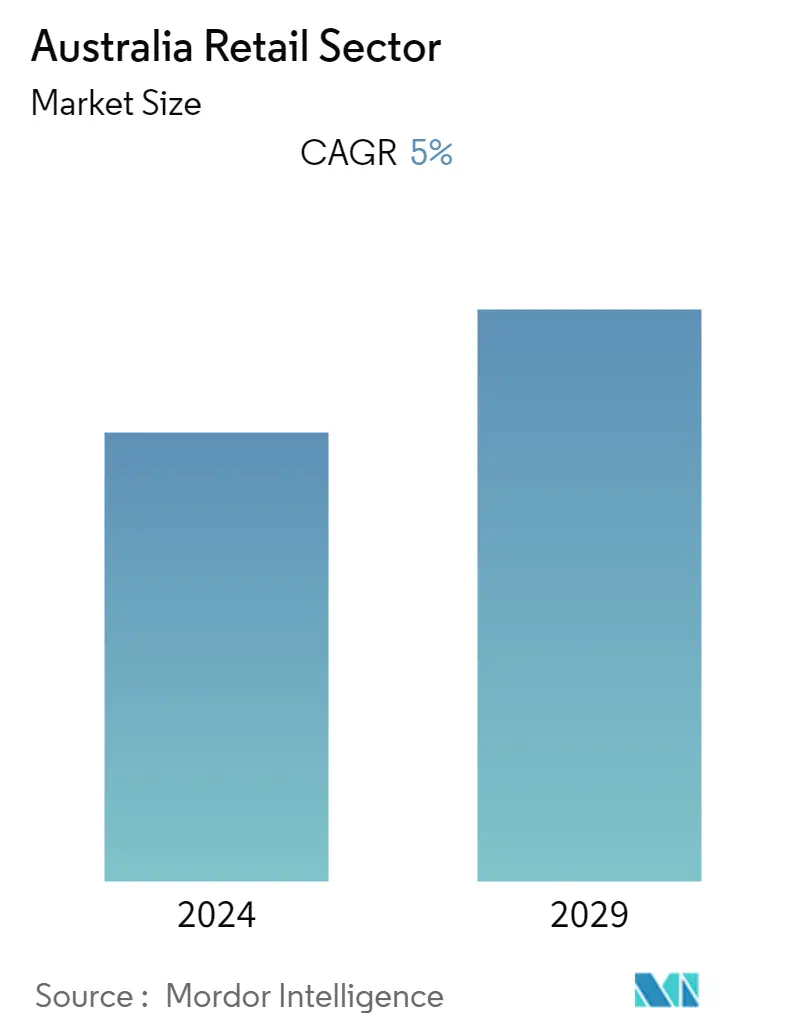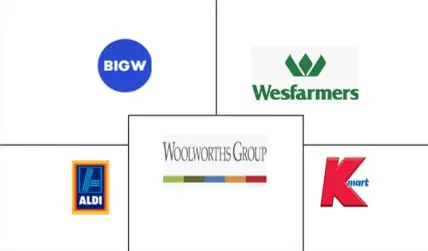Market Size of Australia Retail Sector

| Study Period | 2019 - 2029 |
| Base Year For Estimation | 2023 |
| Forecast Data Period | 2024 - 2029 |
| Historical Data Period | 2019 - 2022 |
| CAGR | 5.00 % |
Major Players
*Disclaimer: Major Players sorted in no particular order |
Need a report that reflects how COVID-19 has impacted this market and its growth?
Australian Retail Market Analysis
The Australian retail industry, which is one of the key contributors to the country's economy, was on a growth trajectory from 2004 to 2019. The total retail turnover was accounted for approximately AUD 329.6 billion in 2019, which was around AUD 9 billion more than the value it recorded in the previous year. However, the sudden COVID-19 pandemic, which hit the country in early 2020, has brought several changes to the retail industry in the country, where it recorded a drop in the total number of sales transactions during the first and second quarters of 2020. Lockdown measures, physical distancing norms, and stay-at-home-to-stay protected protocols have turned one of the largest distribution channels in the country - the physical retailing stores to switch to omnichannel distribution to keep the competition alive.
Australia is one of the most urbanized societies in the world, with more than 24 million people (~90% of the population) living in the urban areas of Sydney, Melbourne, Adelaide, Brisbane, and Perth, as well as in smaller cities and towns within 100 miles of the ocean. Factors such as internet advertising, high brand awareness rate, and the influencer's trend for the product categories, including personal care and household products, footwear and apparel, and others, are helping the market to record more revenue transactions in the country. The trend is anticipated to continue in the forecast period as well, owing to the growing demand for them.
Australian Retail Industry Segmentation
The report on the Australian retail sector provides a comprehensive evaluation of the market, with an analysis of the segments in the market. The Australian retail sector is segmented by products (food and beverages, personal and household care, apparel, footwear and accessories, furniture, toys and hobby, electronic and household appliances, and other products) and distribution channel (supermarkets/hypermarkets, convenience stores, and department stores, specialty stores, online, and other distribution channels).
| By Product | |
| Food and Beverages | |
| Personal and Household Care | |
| Apparel, Footwear, and Accessories | |
| Furniture, Toys, and Hobby | |
| Electronic and Household Appliances | |
| Other Products |
| By Distribution Channel | |
| Supermarkets/Hypermarkets, Convenience Stores, and Department Stores | |
| Specialty Stores | |
| Online | |
| Other Distribution Channels |
Australia Retail Sector Size Summary
The Australian retail industry, a significant pillar of the national economy, experienced a robust growth phase from 2004 to 2019. However, the onset of the COVID-19 pandemic in early 2020 disrupted this trajectory, leading to a decline in sales transactions during the initial quarters. The pandemic prompted a shift from traditional physical retailing to omnichannel distribution strategies, as businesses adapted to lockdowns and social distancing measures. Urbanization plays a crucial role in the retail landscape, with a substantial portion of the population residing in major cities. This urban concentration, coupled with factors like internet advertising and influencer trends, has bolstered revenue in various product categories, including personal care, household products, and apparel. Despite a dip in demand for apparel and accessories during the pandemic, other segments like food and beverages saw significant growth.
The online retail channel emerged as a rapidly expanding distribution method, driven by high urbanization and an increase in e-commerce shoppers. The pandemic accelerated this growth, as consumers turned to online shopping due to restrictions on physical store access. Enhanced payment gateways, omnichannel practices, and expedited delivery options further fueled this trend. The organized retail sector is witnessing substantial growth, with major players expanding their presence and replacing unorganized outlets with larger retail formats. This shift is expected to continue, contributing to the overall market expansion. Key players such as ALDI Group, Big W, JB Hi-Fi Ltd, and Kmart Australia Limited are actively expanding their operations, indicating a positive outlook for the retail industry in Australia.
Australia Retail Sector Market Size - Table of Contents
-
1. MARKET INSIGHTS AND DYNAMICS
-
1.1 Market Overview
-
1.2 Market Drivers
-
1.3 Market Restraints/Challenges
-
1.4 Value Chain/Supply Chain Analysis
-
1.5 Porter's Five Forces Analysis
-
1.6 Consumer Behavior Analysis
-
1.7 Insights into Technological Innovations in the Retail Industry
-
1.8 Impact of COVID-19 on the Market
-
-
2. MARKET SEGMENTATION
-
2.1 By Product
-
2.1.1 Food and Beverages
-
2.1.2 Personal and Household Care
-
2.1.3 Apparel, Footwear, and Accessories
-
2.1.4 Furniture, Toys, and Hobby
-
2.1.5 Electronic and Household Appliances
-
2.1.6 Other Products
-
-
2.2 By Distribution Channel
-
2.2.1 Supermarkets/Hypermarkets, Convenience Stores, and Department Stores
-
2.2.2 Specialty Stores
-
2.2.3 Online
-
2.2.4 Other Distribution Channels
-
-
Australia Retail Sector Market Size FAQs
What is the current Australia Retail Market size?
The Australia Retail Market is projected to register a CAGR of 5% during the forecast period (2024-2029)
Who are the key players in Australia Retail Market?
ALDI Group, Big W, JB Hi-Fi Ltd, Kmart Australia Limited and Kogan.com Ltd are the major companies operating in the Australia Retail Market.

